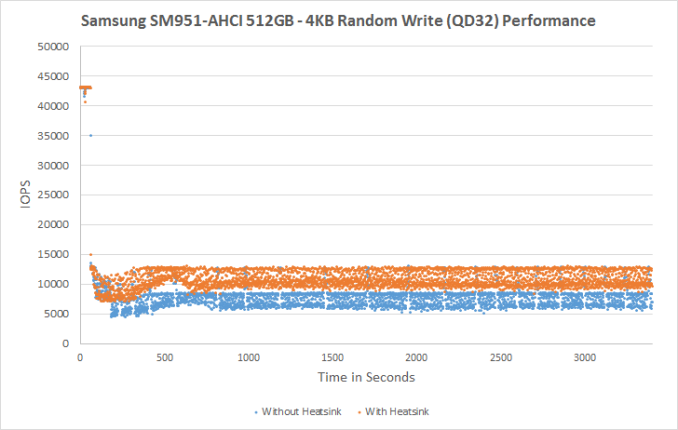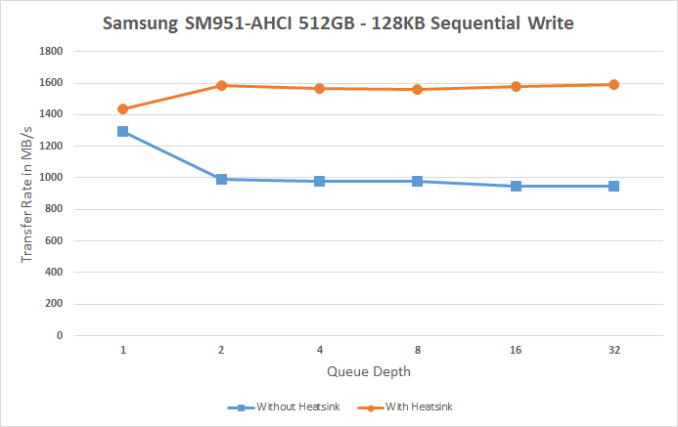Samsung SM951-NVMe (256GB) PCIe SSD Review
by Kristian Vättö on June 25, 2015 9:40 AM ESTThermal Throttling Revisited
When we first tested the SM951-AHCI in February, I noted that the drive seems to be suffering from thermal throttling when subjected to sustained workloads, especially sequential writes. I promised to run tests with a heatsink attached to see what the performance would be without any thermal limitations and now I have some results to present.
For these tests I used the stock 512GB SM951-AHCI and borrowed the M.2 to PCIe adapter with a heatsink from Plextor's M6e Black Edition. Unfortunately I had to send my M6e samples back before I could test the SM951-NVMe, but the purpose of these tests is more to show the impact of thermal throttling in actual client workloads rather than demonstrate the maximum peak performance.
| Samsung SM951-AHCI 512GB Performance | |||
| With Heatsink | Without Heatsink | Performance Delta | |
| The Destroyer (Data Rate) | 471.53MB/s | 455.65MB/s | -3.4% |
| The Destroyer (Latency) | 1323.6µs | 1388.4µs | -4.9% |
| Heavy (Data Rate) | 802.42MB/s | 802.17MB/s | 0.0% |
| Heavy (Latency) | 180.26µs | 181.39µs | -0.6% |
| Light (Data Rate) | 1,250MB/s | 1,240MB/s | -1.0% |
| Light (Latency) | 69.08µs | 69.19µs | -0.2% |
It's clear that the impact of thermal throttling in real world workloads is insignificant. In a worst case scenario where the drive is under a heavy IO workload the performance loss can be 5%, but in anything less intensive the difference is within the margin of error. Even though we truncate idle times to 25µs, it's enough to lighten the workload and reduce thermal throttling compared to a sustained synthetic workload.
Under a sustained 4KB random write workload the difference is more significant as without the heatsink the SM951-AHCI averages 7,878 IOPS, whereas the heatsink bumps that up to 10,873 IOPS.
The same goes for sequential write where throttling is evident and even more significant compared to the random write workload. Without the heatsink the SM951 can sustain peak throughput for about two minutes, which may not sound long but at 1.5GB/s that would translate to 180GB of data written and obviously such massive transfers are very rare.
To sum things up, there is no need to worry about thermal throttling under typical client workloads. There won't be any notable performance loss unless you subject the drive under an intensive sustained workload, which may be relevant to some professional users (e.g. high-end video editing), but not for the typical enthusiast and power user. If you want to ensure that your SM951 operates at full performance at all times, it's not a bad idea to get an adapter with a heatsink, but there is no loss in running the drive without one.












74 Comments
View All Comments
patrickjp93 - Thursday, June 25, 2015 - link
They aren't all storage transfer commands go through the PCH. Your PCIe SSDs do not connect to the CPU directly in most cases. Some enterprise grade drives do, but most consumer do not.Kristian Vättö - Friday, June 26, 2015 - link
PCIe is PCIe regardless of whether the controller is inside the CPU or PCH. PCH merely acts as a hub for different interfaces, but ultimately it connects to the CPU as well since that is where all the processing is done.CajunArson - Thursday, June 25, 2015 - link
Yeah so are we missing some sound and FURY [hint hint] about this SSD on a stick?Kristian Vättö - Thursday, June 25, 2015 - link
Fury X is coming, Ryan just needed one more day because the flu has been undermining his ability to work.DigitalFreak - Thursday, June 25, 2015 - link
(hint hint) The 980ti is faster than the Fury X all around.CajunArson - Thursday, June 25, 2015 - link
I'm not disagreeing with that statement.I just want the review.
lilmoe - Thursday, June 25, 2015 - link
+1A DX12 showdown between FuryX and 980ti would be highly welcome as well.
Gigaplex - Thursday, June 25, 2015 - link
The Fury X wins in some of the 4k tests. The 980Ti seems faster overall, but it's not "all around".mr_tawan - Friday, June 26, 2015 - link
From what I've read, it looks like the Fury has advantages when it comes to memory-intensive use case.SofS - Thursday, June 25, 2015 - link
About the driver issue, how do different operating systems fare? Like 32/64 bits, XP/7/8/10 and Linux old/new (for instance CentOS/Fedora).